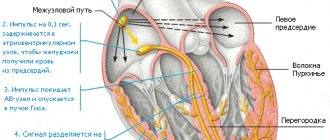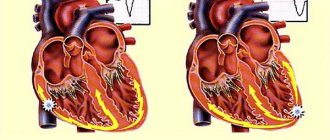Cardiovascular diseases are the leading cause of death worldwide. Most of these diseases manifest themselves in older people, but there are also diseases that occur among young people, up to 35 years of age. They most often develop due to tobacco smoking, excessive alcohol consumption and a sedentary lifestyle.
Inflammatory heart diseases
Heart inflammation has different etiologies:
- Infectious inflammation . Caused by microbes, viruses, fungi.
- Autoimmune inflammation . Associated with immune disorders.
- Traumatic inflammation . Develops in the postoperative period.
There are a number of inflammatory heart diseases (such as endocarditis, myocarditis or pericarditis) that can lead to serious complications without medical intervention.
Necessary preventive measures
Proper nutrition, including a sufficient amount of proteins, fats and carbohydrates, serves as a preventive measure for coronary heart disease. You should also exclude from your diet foods containing large amounts of cholesterol and animal fats. Vegetables, fruits, lean meat, fish and seafood are allowed to be consumed with virtually no restrictions. To create an individual diet, it is recommended to consult a nutritionist.
Factors that positively affect the health of the heart and blood vessels:
- Normal body weight. It is calculated using the BMI formula (height in cm divided by the square of height in meters). To lose weight, you should consume a strictly defined amount of calories, if possible not to exceed the norm. Plus, it is also recommended to remove simple carbohydrates from your diet and minimize sugar consumption.
- Sports activities. Even light walks and exercise will help improve heart function.
- Elimination of stress factors.
- Bad habits should be eliminated. Quit smoking and limit your alcohol consumption.
- Controlling blood pressure.
Early detection and treatment of IHD virtually eliminates the development of complications.
Vascular lesions
Vascular diseases include diseases such as varicose veins, atherosclerosis, aneurysm, etc. All these diseases develop against the background of deteriorating vascular condition and arise due to various factors.
The cause of vascular diseases can be age, poor diet, smoking and drinking alcohol, and a sedentary lifestyle. Some diseases can lead to serious complications. With atherosclerosis of the vessels of the extremities, gangrene may develop, while aortitis leads to a more severe form of the disease - aortic aneurysm.
In the Medicenter clinic network, it is possible to undergo a complete examination of the circulatory system and identify any cardiovascular disease.
PREVENTION OF RISK FACTORS FOR CARDIOVASCULAR DISEASES IN CHILDREN AND ADOLESCENTS
25.Sep.2020
September in Ugra is dedicated to the prevention of diseases of the cardiovascular system. They are known to be the leading cause of death and disability in the world. About the main causes and risk factors for the disease in children and adolescents - in the material from the pediatric cardiologist of the children's outpatient department No. 5 of the Nizhnevartovsk city children's clinic Ekaterina Andreevna Obukhova.
Diseases of the circulatory system are one of the most pressing problems in many countries of the world. Diseases of the circulatory system shorten human life expectancy and are the main cause of disability, as well as sudden death. According to WHO, cardiovascular diseases, including heart attack and stroke, are the leading cause of death in the world. They claim 17.5 million human lives a year. Among socially significant diseases, they occupy first place. Often the origins of these diseases in adults are in childhood and adolescence. Known risk factors for coronary heart disease—excess body weight, smoking habit, and low physical activity—begin to develop in childhood and adolescence.
Starting in childhood, most of them accompany a person throughout his life. Children are increasingly suffering from adult diseases - arterial hypertension, coronary heart disease, rhythm disturbances and even atherosclerosis. These diseases progress and often cause disability in older age. For children, everything is really “grown-up”. This is confirmed by the following fact: currently one of the pressing problems of pediatric cardiology is heart rhythm disturbances and arterial hypertension. In recent years, the number of children with hypertension and high blood pressure has increased significantly.
Remember how long ago your child visited a pediatrician? Did they measure his blood pressure? Did your son or daughter have a cardiogram before going to the sports section? It would seem that these are trivial questions, but the health and future of the child often directly depends on them. Unlike adults, children rarely complain of symptoms characteristic of diseases of the cardiovascular system, so a more thorough examination is necessary.
Cardiologists also note that it should be remembered that with a mild severity of the disease, a child can grow and develop normally for a long time, play and run with healthy children. However, untimely diagnosis of heart disease can lead to severe heart failure in the future. Experts note that a healthy lifestyle is of great importance in preventing heart and vascular diseases. First of all, you should give up bad habits. The risk of heart disease increases with excess body weight. However, not everyone succeeds in changing their lifestyle and diet. Meanwhile, this is necessary to maintain health. At least 80% of premature deaths from heart attacks and strokes can be prevented by eating a healthy diet, regular physical activity, not smoking, and maintaining a healthy body weight. Lifestyle changes are the best way to prevent complications or reduce the risk of heart disease. The main ways to reduce the risk of heart disease should be controlled by the patient himself, not doctors. In order to prevent problems with the heart and blood vessels from overshadowing the life of an adult, a number of recommendations should be followed from childhood.
Prevention of cardiovascular diseases
Balanced nutrition
Children should have a nutritious diet that meets the physiological needs of a growing body. The content of vegetable fats in the diet should be at least 30% of the total fat. Fresh vegetables, fruits, and juices are beneficial, but tonic drinks, extractives, and foods containing easily digestible carbohydrates should be limited. Of the microelements, potassium and magnesium are “loved” by the heart (these are dried fruits, pumpkin, zucchini, eggplant), and sodium (salt) is “unloved”. For a certain part of the population, the cause of the disease is excessive salt consumption. Limiting salt intake (up to 5 g) should primarily concern those who are obese and have a family history of arterial hypertension. If a child eats properly, this helps prevent obesity, maintain normal blood pressure, and maintain the required level of cholesterol and glucose in the blood. The greatest risks of developing obesity in children are in the first year of life, at 5-6 years old, during puberty. Exclusive breastfeeding up to 4 - 6 months is the best care for the heart of a newborn baby. When breastfeeding, the baby himself regulates the amount of food he needs. In addition, breast milk changes its taste depending on the foods that the mother eats. Thus, if a woman eats a varied diet, there is a greater chance that the child, after introducing complementary foods, will favorably accept healthy foods. In the future, it is important that the child’s diet is complete and includes foods from different groups.
The child's menu should contain: ▪ meat and meat products ▪ fish and fish products ▪ milk and dairy products ▪ eggs ▪ fruits and vegetables ▪ bread and bakery products ▪ cereals, pasta and legumes ▪ edible fats, sweets and confectionery
What principles should be followed?
It is important to correctly calculate the proportions, how much and what to include in the diet. Try to imagine a “healthy plate” of food for your child. Half of it will consist of vegetables and fruits, a quarter of foods high in starch (potatoes, rice), and a quarter of protein sources (meat, fish, poultry, eggs). Sugar should be consumed approximately 40 - 50 g, confectionery products - 20 - 25 g per day. It is necessary to minimize your child's salt intake. Constant consumption of salty foods is a risk factor for the development of arterial hypertension. At the same time, preference for salty foods is an acquired habit. Therefore, it is better not to overuse canned meat or fish, salty cheeses, sausages and delicacies. It is also important to properly organize the ritual of eating. If you forcefully restrict a child from certain foods, this will only increase their attractiveness. On the contrary, pushing porridge and vegetables into the mouth will only lead to the child hating them. Divide responsibilities at the table. Your tasks: firstly, to provide a healthy, varied and nutritious diet; secondly, create a favorable and friendly atmosphere at the table. The child’s task is to choose what and when, in what quantities to eat. Try to suppress your natural parental desire to force your child to eat “at least one more spoon.” Another rule to follow: set a positive example. It is much easier to persuade a child using the “Do as I do” method rather than the “Do as I say” method. Eat a healthy diet yourself. This will benefit both you and the child.
Physical exercise
According to cardiologists, for good health, adults and children over 5 years of age need 30 minutes of moderate physical activity daily and 3-4 times a week for 30 minutes of intense physical activity. Examples of moderate physical activity are:
- brisk walking 3 km in 30 minutes;
- cycling 8 km in 30 minutes;
- dancing at a fast pace for 30 minutes;
- basketball, volleyball game 30 minutes.
The problem of physical development is especially relevant in the modern world.
The main leisure time for children is no longer playing football in the yard, but computer games. Often a child is taken to kindergarten or school by car, which makes life much easier, but at the same time eliminates even minor physical activity. To prevent heart problems, children over 2 years of age should get at least 30 minutes of moderate exercise per day. Daily. Of course, it is impossible to force a small child to perform strictly prescribed exercises. But this is not what we are talking about. You can walk more, and older children can ride a bike. Climb stairs if possible. Helping with active chores around the house is also physical exercise. Children from 6 to 17 years old are recommended to exercise at least 60 minutes every day. Moreover, if a child is involved in some kind of sport, it is important to focus on participation, and not on winning the competition. Otherwise, failures may push the child away from physical exercise altogether. Children should be given no more than 2 hours a day for sedentary activities. Of course, if certain habits have already been formed, it is very difficult to switch to a healthy lifestyle. Therefore, the regime needs to be changed gradually: increase the time allotted for active activities by 30 minutes, and reduce “sedentary” activities by 30 minutes every day. Unlimited TV viewing is fraught with another problem. Remember what is usually advertised during the day? Sugary cereals, fast food, sugary drinks and candy. Nobody advertises vegetables and fruits! Thus, a sedentary lifestyle is often associated with the formation of cravings for “junk food.” All this contributes to the development of obesity and arterial hypertension. Weight control
It's no secret that the number of overweight children is growing. An obese child is usually a potentially overweight adult. Such children develop a number of socio-psychological problems that persist for many years, sometimes for life. Many researchers believe that heredity plays a big role in the development of obesity. If both parents are overweight, up to 80% of children are also overweight. Two factors are combined here: hereditary predisposition and the habit of improper, irrational nutrition, due to family traditions. The development of obesity is largely determined by overeating and low physical activity. Unfortunately, many parents feed their children incorrectly. The opinion of such parents - “a plump child is a healthy child” - is very far from the truth. Obesity is based on an imbalance between the body's energy intake and its expenditure. Correcting nutrition, increasing physical activity and taking into account the psychology of an overweight child are necessary components of normalizing his weight.
Rejection of bad habits
Smoking, drinking beer and alcohol have become the norm among teenagers. The example of parents is important in giving up bad habits. Often it helps to talk with a teenager about how a different lifestyle is fashionable now. Nowadays it is fashionable not to smoke, but to lead a healthy lifestyle, play sports, and do fitness! Yes, yes, you need to think about the problem of smoking even in childhood. If one of the parents of a small child smokes, the child himself becomes a smoker, only a passive one. In addition, children of smoking parents more often suffer from bronchopulmonary diseases and otitis media. If you couldn't quit smoking for yourself, try to do it for the sake of your child. From the age of 8, pediatricians are recommended to ask the child whether he or she smokes. According to statistics, children from families with low social status smoke more often. By the way, a lot of pocket money can also push a child to try smoking. If you suddenly find out that a child or teenager smokes, you should not punish him, scold him, or intimidate him. Reasonable facts must be presented. Talking about your risk of getting lung cancer in the future may not have the desired effect. During the survey, only 5% of teenagers answered that they would smoke as adults (in reality, 75% continue to smoke). It’s better to say that people who smoke have bad breath, their teeth turn yellow, and their clothes smell of smoke. If you smoke yourself, you shouldn’t say: “I’m big, I can do it.” It's better to openly admit that you smoke because you can't get rid of the habit. Point out the benefits of quitting smoking: the child will get fewer colds, his success in sports will improve, he will look better, he will be able to spend money on more interesting things than cigarettes.
Monitoring the child's growth and health
If a child or his parents have any complaints, are bothered by any symptoms, and also if there is a family history of cardiovascular diseases, then you should immediately contact a specialist at the clinic. The doctor will conduct an examination and, if necessary, prescribe the necessary examinations. To prevent hypertension in children and adolescents, it is important to have early detection of high blood pressure, step-by-step treatment, and long-term medical examination with lifestyle correction. It is important to monitor indicators, changes in which may serve as a signal that the risk of heart and vascular diseases in a child is increased. In children, it is necessary to determine the level of total cholesterol in the blood. This can be done between the ages of 2 and 10 years. Elevated cholesterol levels are a reason for a more thorough examination of the child. At the age of 3 years, it is recommended to start measuring blood pressure. Its increase is promoted by obesity, excess salt consumption, and a sedentary lifestyle. When the baby is born, it is important that parents know their cholesterol levels and blood pressure. If the indicators differ from normal, this is also a reason for a more thorough examination of the child. An alarming signal is the early manifestation of cardiovascular diseases in close relatives: grandparents, their brothers and sisters. For men it is 55 years old, for women it is 65 years old. If a child already has problems with excess weight, blood pressure, or high blood cholesterol, it is better to immediately consult a doctor: pediatrician, cardiologist, endocrinologist, qualified nutritionist. Start caring for your child's healthy heart today. This will help him become an active and successful person in the future.
Diet
A diet for coronary artery disease involves reducing the consumption of animal fats, since such foods contribute to the deposition of cholesterol plaques in the coronary arteries and are the main factor in the development of coronary artery disease.
The amount of fat in the diet of a person with coronary heart disease should not exceed 85g. per day. It is recommended to replace some of the saturated fats with unsaturated fats, for example, add more fish containing Omega-3 fats to your diet.
Fats, as a rule, are found in baked goods, processed meats (sausages, sausages), milk, etc., therefore, you should also limit yourself from consuming foods of this type.
If you have coronary artery disease, a person should reduce cholesterol-containing foods. Plus, it is necessary to minimize the amount of sweets and ice cream consumed.
Milk, especially those with a high fat content, should also not be consumed frequently. Limit your consumption of cottage cheese and cheese, which contain large amounts of animal fat.











